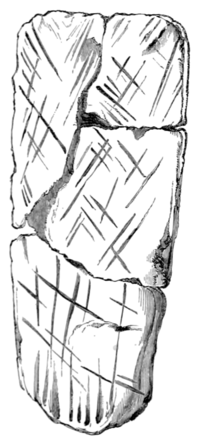W. O. Stanley, who has deposited in the Museum the curious urns found in a tumulus at Porth Dafarch, Anglesea. They have been fully noticed in a previous volume of the Journal[1] Another urn of unusual form has been presented to the Museum by Mr. Tomkins. It was found about twenty years ago in the centre of one of a group of seven barrows on a farm in the Parish of Broughton, Hampshire, and contained ashes. The urn is remarkable for two auricular projections on the prominent ridge of its exterior; the material is a coarse clay, slightly baked.
Among the Roman remains must be especially mentioned a stone sarcophagus presented by Henry Long, Esq. It is formed out of the malm-rock (lower chalk) and is a singular instance of so large a mass of that rock. It consists of a stone cist and cover, represented in the accompanying engraving; the cover is broken in several places, and is indented with rude scorings which are probably the marks of the ploughshare. It was found several years ago at a farm called Wheatleys, in the parish of Binstead, Hampshire, a little to the south of the Holt forest. It contained when found a skeleton and several small terra cotta vessels, six of which have been preserved. The three principal ones are black, the others which appear to have been used as covers, are of a light red. The spot where the discovery was made is a knoll on the verge of the malm escarpment, overlooking the valley of Kingsley and the forest of Woolmer. The Duchess of Grafton has presented the fragments found in the
- ↑ Arch. Jour., Vol. vi., p. 226.

